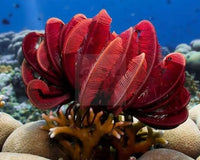Embarking on the journey of setting up a reef aquarium can be both exciting and daunting, especially for beginners. A thriving reef aquarium not only beautifies your home but also provides a peaceful environment for marine life to flourish. This guide will walk you through the key steps in making your beautiful underwater ecosystem livable, from aquarium setup to aquarium maintenance, ensuring that both your marine fish and corals thrive.
Here at Marine World Aquatics can supply the ultimate package in aquariums to suit your budget
Choosing the Right Aquarium
The first step in the process is choosing the correct size and type of aquarium. Popular models like the D-D Reef Pro 1200 Aquarium, D-D Reef Pro 1500 Aquarium, and D-D Reef Pro 1800 Aquarium provide ample space for your aquatic inhabitants. A larger aquarium may require more initial investment but makes maintaining stable water conditions easier, which is crucial for marine fish and coral care.
Essential Equipment for Your Reef Aquarium Setup
Once you have chosen your aquarium, it’s time to gather essential equipment. Key items include:
- Filtration System: A reliable filtration system is essential for maintaining clean water conditions, which is vital for the health of your coral and fish.
- Lighting: Proper lighting provides the necessary spectrum for coral growth. LED lights that mimic natural sunlight are recommended.
- Heating: Marine species often require warmer temperatures, so a good quality aquarium heater will help maintain the right temperature.
- Salt Mix: Using a high-quality salt mix is critical for creating a suitable marine environment. The correct salinity is vital for fish and coral health.
- Protein Skimmer: A protein skimmer removes organic waste before it breaks down, promoting a cleaner environment.
Before introducing any fish or corals, allow the tank to cycle for several weeks. This process establishes beneficial bacteria that will help maintain a healthy aquarium ecosystem.
Choosing Marine Fish and Coral
Selecting the right fish and coral is crucial. Beginners should start with hardy fish species such as Clownfish or Damselfish. As you gain experience, you can gradually introduce more sensitive species. When it comes to coral care, soft corals are an excellent starting point, as they are generally easier to manage than hard corals. Ensure that you research each species’ specific tank requirements before introducing them to your aquarium.
Cycling Your Aquarium
The cycling process is an important step in establishing a reef aquarium. It typically takes 4 to 6 weeks but can vary based on different factors. To cycle your aquarium:
- Start by adding a source of ammonia, which can be achieved with fish food or ammonia drops.
- Test the water regularly to monitor ammonia, nitrite, and nitrate levels.
- Once ammonia and nitrite levels drop to zero, and nitrates rise, your tank is cycled and ready for inhabitants.
- all-in-one Bacteria ATM Colony Saltwater*" – Marine World Aquatics
Patience is key here; rushing the process can lead to ill-fated outcomes for your marine life.
Acclimating Your Fish and Corals
When your aquarium is ready, acclimating fish and corals to their new environment is crucial. The drip acclimation method works well, allowing the fish and corals to gradually adjust to the water parameters in your reef aquarium. This process helps reduce stress and shock associated with a sudden change in environment.
Caring for Your Reef Aquarium: Maintenance Tips
Once your reef aquarium is established, proper aquarium maintenance is vital to keep your marine life healthy:
- Regular Water Testing: Test your water parameters (pH, ammonia, nitrite, nitrate, and salinity) weekly to ensure they remain stable.
- Water Changes: Performing regular partial water changes (10-20% every 1-2 weeks) helps remove waste and replenish essential minerals.
- Cleaning: Clean algae and other debris from the aquarium’s glass and decorations. Just be careful not to disturb the inhabitants too much.
- Monitor Fish and Corals: Keep an eye on the health of your fish and corals, looking for signs of distress or disease.
In this aspect, the right aquarium setup is fundamental for successful aquarium maintenance. Products like the D-D Reef-Pro 900 Aquarium offer a great balance of space and equipment to ease maintenance efforts.
Common Challenges in Reef Keeping
Reef keeping comes with its challenges. Fish diseases, algae blooms, and coral bleaching are common issues that may arise.
- Fish Diseases: Quarantine new arrivals before introducing them to your main tank to prevent disease spread.
- Algae Blooms: Maintain stable nutrient levels and avoid overfeeding to combat algae growth.
- Coral Bleaching: Ensure your corals receive the appropriate light levels and water flow to avoid bleaching.
Understanding these challenges and addressing them promptly will save you from larger headaches down the line.
Join the Reef Keeping Community
Joining forums or local reef clubs can provide invaluable support. Networking with other enthusiasts can offer insights, cues, and solutions that can be gained from collective experience.
Conclusion
Setting up and maintaining a reef aquarium requires commitment, patience, and ongoing learning. However, the joy of creating and nurturing your vibrant underwater world is immensely rewarding. As you embark on this journey, remember that proper aquarium setup and consistent maintenance will dictate your success in marine fish care and coral care. With a focus on using quality products and continually educating yourself, your reef aquarium can become a thriving ecosystem.





